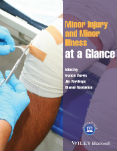-
1. Define an abrasion.
Show Answer
Correct answer: An abrasion is injury caused by friction shearing the skin away
See Chapter 3.
-
2. Define a contusion or bruise.
Show Answer
Correct answer: Bleeding into the skin or solid organs
See Chapter 3.
-
3. Define a laceration.
Show Answer
Correct answer: Wound caused by blunt or crushing force
See Chapter 3.
-
4. Define a cut.
Show Answer
Correct answer: Wound caused by a sharp object, like a knife or glass
See Chapter 3.
-
5. What are the three essential elements of wound care?
Show Answer
Correct answer: A, Anaesthesia
C, Cleaning
E, Examination
See Chapter 3.
-
6. Give four types of wound that are not suitable for closure in a minor injury setting.
Show Answer
Correct answer:
- Wounds more that 6–12 h old – infection risk
- Bites, especially to the hand
- Infected wounds; do not try to close these
- Heavily contaminated wounds
- Severe crush injury
- Evidence of damage to deeper structures
See Chapter 3.
-
7. What are the potential complications of the following wounds:
(a) Cut with a knife to the palm
(b) Wound to the dorsum of the metacarpophalangeal joint (MCPJ) caused by a tooth
(c) Glass wound to the sole of the foot
(d) Injury from a garden fork
(e) Bite from a dog while abroad.
Show Answer
Correct answer:
(a) Cut with a knife to the palm.
Damage to nerves and tendons
(b) Wound to the dorsum of the metacarpophalangeal joint (MCPJ) caused by a tooth.
Tendon injury and MCPJ septic arthritis
(c) Glass wound to the sole of the foot.
Retained foreign body
(d) Injury from a garden fork.
High tetanus risk
(e) Bite from a dog while abroad.
Rabies
See Chapter 3.
-
8. Match the following terms with their descriptions: furuncle, folliculitis, cellulitis, erysipelas, carbuncle, necrotising fasciitis, scabies.
(a) Hair follicle infection.
(b) An itchy rash on the wrist and fingers
(c) Rapidly progressive, blistering, cellulitis and systemic upset.
(d) Red, painful, shiny lower leg associated with a small wound.
(e) A boil.
(f) Cellulitis with very clear margins.
(g) A mass of boils forming one large abscess with multiple heads.
Show Answer
Correct answer:
(a) Hair follicle infection.
Folliculitis
(b) An itchy rash on the wrist and fingers
Scabies
(c) Rapidly progressive, blistering, cellulitis and systemic upset.
Necrotising fasciitis
(d) Red, painful, shiny lower leg associated with a small wound.
Cellulitis
(e) A boil.
Furuncle
(f) Cellulitis with very clear margins.
Erysipelas
(g) A mass of boils forming one large abscess with multiple heads.
Carbuncle
See Chapters 4 and 5.
-
9. Describe the likely depth of injury in the following scenarios:
(a) A scald to the hand with hot but not boiling water; it is very painful with reddening of the skin and a few thin-walled blisters.
(b) A scald with hot fat to the arm; the blisters have burst and the skin is dark red but sensation is intact.
(c) A burn caused by molten metal; it is not too painful but the skin is white and leathery.
Show Answer
Correct answer:
(a) A scald to the hand with hot but not boiling water; it is very painful with reddening of the skin and a few thin-walled blisters.
Superficial partial thickness
(b) A scald with hot fat to the arm; the blisters have burst and the skin is dark red but sensation is intact.
Scabies
(c) A burn caused by molten metal; it is not too painful but the skin is white and leathery.
Full thickness
See Chapter 6.
-
10. List the indications for referral to a burns unit.
Show Answer
Correct answer:
- Superficial burns more than 10% body surface area
- Age less than 5 years or more than 60 years
- Significant burns of the hand, face or perineum
- Full thickness burns of the feet
- Circumferential burns
- Inhalational injury
See Chapter 6.
-
11. List the signs of smoke inhalation.
Show Answer
Correct answer:
- Increased respiratory rate/dyspnoea
- Soot around nose and mouth
- Singeing of facial/nasal hair
- Soot in mouth
- Burns in and around mouth and nose
See Chapter 6.

